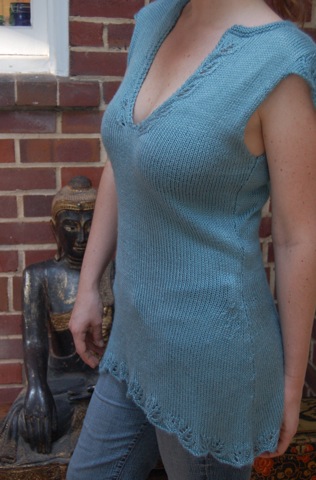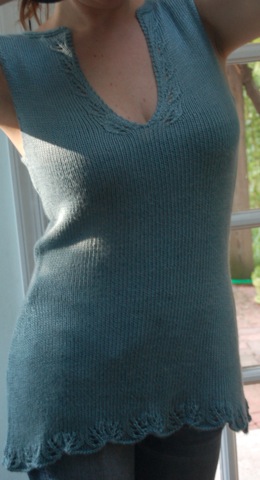~~
Encore une petite absence pour raisons de santé et visite-éclair de mes parents chéris, mais j’ai quelque chose de chouette à vous montrer!!
Une jolie tunique d’été qui s’intitule Camellia, par Kate Gilbert (cliquez pour le patron). Je l’avais repéree sur Ravelry, et je me suis dit que ce serait le modèle parfait pour faire usage de mon bambou/soie bleu-gris (Patons Silk Bamboo en coloris Sea)
~~
~~
~~
~~
~~
Verdict? RA-VIE! La laine est un plaisir à tricoter, d’une douceur merveilleuse… Le drapé est incroyable, mais attention mieux vaut tricoter un peu juste car ça se détend un peu au blocage. Le blocage (bain + séchage à plat) est d’ailleurs indispensable pour que les parties en trous-trous se positionnent bien.
Mais je suis vraiment contente, et j’ai eu plein de compliments, y compris de la part de la gente masculine — mais je crois que le décolleté plongeant y est pour quelques chose 😉
~~
Another short absence due to health reasons, and a visit from my folks. BUT I have something neat to show you!
A pretty tunic that I had first seen on Ravelry : Camelia by Kate Gilbert. And the yarn (which isn’t the right gauge but I made some adjustments to the pattern to offset this) is Patons Silk Bamboo in Sea colorway.
~~
I couldn’t bee happier with the result, it’s very comfy and the drape of this yarn is unreal. I’m now a huge fan of bamboo. The only thing to watch for is that it tends to stretch upon blocking (and blocking is absolutely necessary for this project) so the best thing is to err on the snug side I think. I received a lot of compliments when I first wore this, and I think I might knit it again soon, maybe in a cotton blend (and a shorter length) next time.










